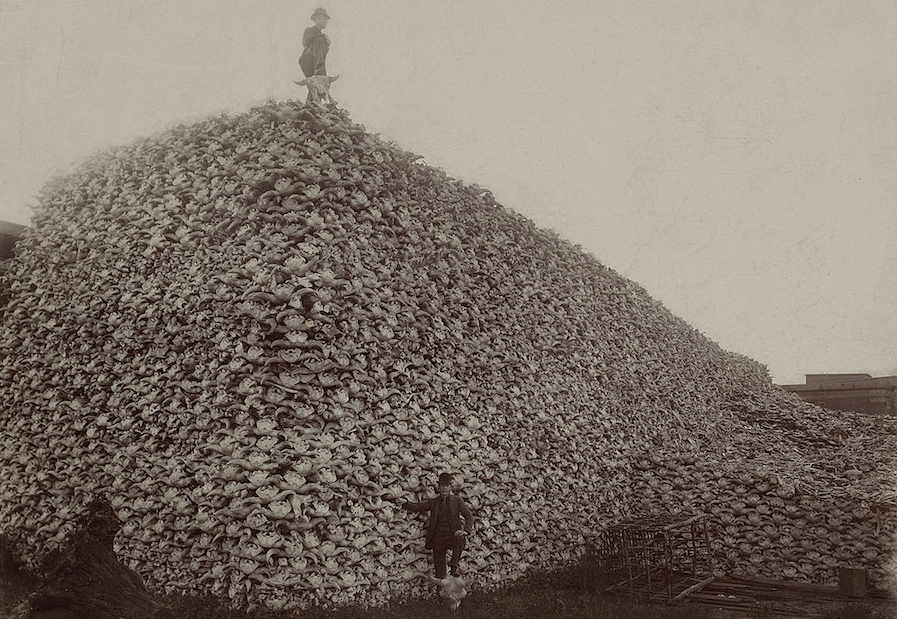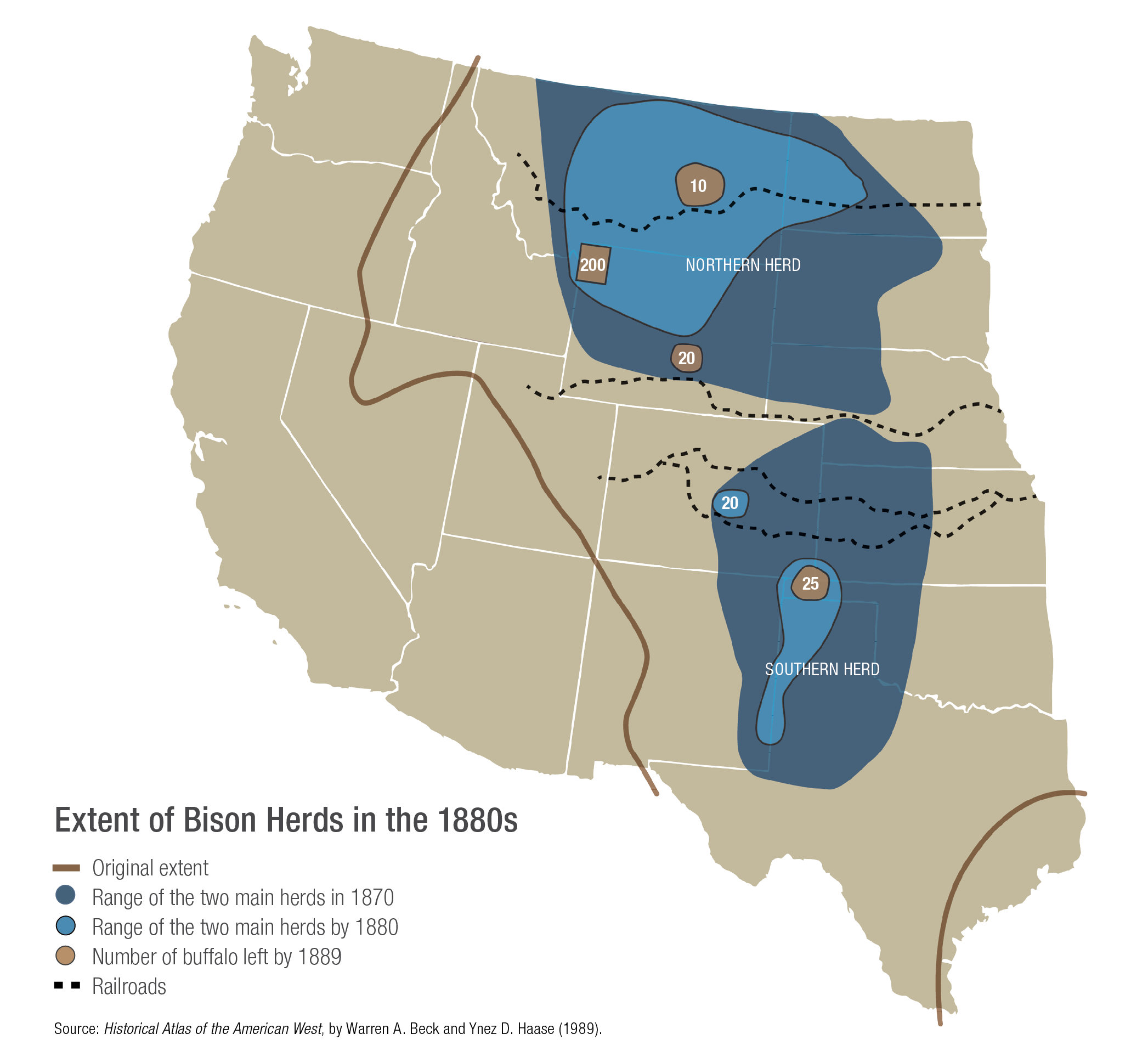North America was once home to massive herds of bison. Approximately 30 million bison roamed the plains during the 19th century, and in 1870, there were still at least 10 million bison on the continent.
But by the mid-1880s, that figure had fallen to less than 1,000. Entire herds were wiped out in a matter of years. “In 1880, the country was practically uninhabited,” wrote early rancher Granville Stuart, describing the plains of Montana. “One could travel for miles without seeing so much as a trapper’s bivouac. Thousands of bison darkened the rolling plains.”
That all changed in just a few years. “In the fall of 1883 there was not one bison remaining on the range” in Montana, according to Stuart.
The story of how this massive “slaughter on the plains” occurred with such speed and ferocity has been well documented. The near extermination of bison and the massive harvesting of them by white hunters continues to hold great interest among historians of the American West. The species has recently garnered renewed interest: In May, President Obama signed a bill designating the bison as the U.S. national mammal. The question of why the historic bison slaughter happened, however, has received less attention. And the explanations that exist often lead to incorrect conclusions about this era.
An Alternative Explanation
The usual explanation of this rapid depletion of the bison—at least among economic historians—was the lack of ownership of them. Because no one owned the bison, the story goes, no one had an incentive to protect them, resulting in a “tragedy of the commons.” Although some Indian tribes had loosely defined claims to certain areas to hunt the animals, those claims were virtually extinguished as settlers moved westward. In essence, bison were taken on first-come, first-served basis, with no incentive to account for the future of the population. Anyone could kill bison on the plains as rapidly as they wished.
This lack of well-defined and enforced property rights is the root cause of virtually all environmental problems. But upon closer examination, it does not adequately explain the demise of the bison during this period. In a recent academic article, published in the Independent Review, I offer an alternative explanation: The bison were slaughtered not because of a lack of property rights to them, but because there was a higher-valued use of the land on which their massive herds thundered. In other words, even if property rights could have been established to the bison herds, settlers would likely have slaughtered them anyway. The plain fact was that, during this period, a bison was worth more dead than alive.
The bison were slaughtered not because of lack of property rights to bison, but because there was a higher-valued use of the land on which their massive herds thundered.
The most valuable resource on the plains at the time was not actually the bison, but the grass beneath their hooves. The prairie grasses on the Great Plains were the bison’s primary food source. As railroads ventured westward, however, that grass became increasingly valuable for another purpose: meat production. But not just any meat—specifically beef, which would require grazing lands to run cattle.
Bison, of course, are also a source of meat. But for a variety of reasons, bison meat was extremely expensive to deliver to market during this time period. Domesticated cattle, on the other hand, could produce beef from the grasses of the plains much more efficiently. Since bison were in direct competition with cattle for space, their demise was inevitable. The result was a massive slaughter of bison over little more than a decade.
A second factor fueled the slaughter: growing demand for bison hides as a result of technological innovations in tanning. Economist M. Scott Taylor of the University of Calgary recently documented this phenomenon, arguing that English and German tanners were the first to discover a workable process for tanning bison hides. By 1871, technological change in tanning meant that bison hides had become almost identical to cattle hides for commercial use. Demand for bison hides boomed over the next decade as a result.
With bison hides fetching between $3.00 and $3.50 apiece at railheads, thousands of hide hunters outfitted themselves with wagons, rifles, and crews of skinners. These groups could kill several hundred bison in a day. The hides were stacked, bundled, and hauled to railroads where they were shipped east for tanning.
The hide trade sped up bison harvesting remarkably. The Western Kansas herd was eliminated in less than four years (1871-1874), the herds in western Texas were exterminated in five (1875-1879), and the bison of eastern Montana were killed off between 1880 and 1883.
If bison represented a viable form of production over the long run, either for meat or for hides, one would expect to see efforts to establish rights to bison and attempts to raise them for market. Yet there is no record of ranchers attempting to do so during this period.
The Bison Commons
After 1870, with the railroads expanding and the gradual pacification of Native American tribes, ranchers began to exert a new set of economic values upon the western landscape—one that did not include millions of bison roaming the plains. In fact, the bison herds presented a challenge for ranchers in the West: Bison consumed grass and disrupted cattle production, so their removal was virtually an economic necessity, not necessarily a tragedy or waste of resources.
In this sense, the true economic cost of having bison around was rising dramatically. Herds of bison meant less room for cattle, and less grass for them to eat.
Compared to cattle, bison were not a practical means of converting grass to meat. This was not because the meat was unpalatable. Railroad crews depended heavily on bison for their sustenance, and early residents of forts often engaged in meat trade with Indians. The major problems with bison had to do with production—they are difficult to confine, difficult to raise, and difficult to bring to market.
Bison cannot be gathered and trailed like cattle. “Bison is nothing at all like a cow critter,” as one participant in a 1906 roundup put it. “A bison ain’t afraid of nothing and don’t stick with the herd like a cow will.” Ten cowboys could easily trail 3,000 head of cattle. But ten cowboys could hardy herd ten bison to a common point.
Indeed, bison are one of the large animal species that Jared Diamond, author of Guns, Germs, and Steel, lists as incapable of domestication. One bison historian reports that, even when raised from calves and gentled over a long period of time, “they have almost always sooner or later turned on their trainers, and some of these later have been killed by them.” When Michel Pablo, who owned 800 bison on the Flathead Reservation, contracted to sell his herd to the Canadian government in 1906, it took five years of intense effort to get the bison captured and transported.
Because of these challenges, bison had to be killed on-site, dressed, loaded onto wagons, and then moved to a railhead. After 1872, refrigerated cars were available, so it would have been possible to slaughter bison and move them by wagon to the railroad, where they could be transported to eastern markets. But the cost was prohibitive. As economist John Hanner describes, “Even in cold weather when meat could easily be saved, overland carriage across the plains was so demanding of time and effort that only bison killed within a short distance of a rail depot were normally butchered.” In contrast, cattle could be trailed directly to a railhead, so moving a cattle herd was much cheaper than transporting bison.
At the time, based on my estimates, hauling one ton of bison carcasses a mile toward a railhead cost approximately 30 cents. Trailing cattle to a rail line, on the other hand, cost less than two cents per ton-mile. Given such a large difference in costs, it is not surprising that ranchers were loathe to even consider bison as a viable alternative to cattle production on the plains.
Transporting cattle had yet another advantage: They could be moved live to a slaughterhouse, eliminating any danger of spoilage. In contrast, bison could be transported only in the wintertime, by refrigerated car, or after preservation, as with the pickling of tongues. Each of these were much higher-cost alternatives than delivering cattle to market.
The hide market, therefore, performed a useful function for cattle ranchers arriving on the scene. Because hides were valuable, at least some economic gain could be captured by the slaughter of the bison. In the absence of the hide market, bison would have, in all likelihood, simply been killed and left to rot.
Almost as quickly as bison were removed from the plains, cattle began to flourish. “In 1880, no one had ever heard tell of a cowboy in ‘this niche of the woods,’” wrote Granville Stuart, “but in the fall of 1883, there were 600,000 head of cattle on the range.” Hanner estimates that by 1890 there were more cattle on the High Plains than there had been bison 20 years prior.
Bison Today
But what about other values? Didn’t the simple value of their existence mean that killing several million bison represented a tragedy?
It is difficult to calculate how many bison it would take to satisfy the non-commercial demand for them. But it is clear that once bison numbers dwindled to a small amount, entrepreneurs recognized that each additional bison became more valuable and took steps to preserve them.
In the winter of 1872-1873, a Pend d’Orielle Indian captured eight orphaned bison calves. By 1884, his herd had grown to 13 head, and he later sold them to Charles P. Allard and Michel Pablo. The purchase price showed how much the value of bison had risen—$154 per head, at a time when cattle went for just $25 per head. The bison were run on the Flathead Reservation in northwestern Montana and grew to 300 head by 1896. When Allard died, his share of the herd was sold to several buyers, but Pablo kept his herd intact. In 1906, Pablo tried to sell his herd to the U.S. government but was unsatisfied with the price offered. He later sold the herd to the Canadian government for $200 a head.
Once the bison’s value as an ecological curiosity increased, efforts to preserve the species became successful. Today, there are numerous bison ranches, some of which produce bison for the meat market. Herds also live on public preserves such as Custer State Park in South Dakota, Yellowstone National Park, and the National Bison Range in Montana. The National Bison Association reports that there are 450,000 bison in North America, with about 220,000 of those in the United States. Approximately 90 percent of U.S. bison are in private hands, with the remainder in public parks and preserves.
The story of the American bison is one of rational individuals operating under an institutional framework that did not necessarily create a tragedy of the commons. It is true that property rights were not well defined and established for bison on the open prairies, but since they were not viewed as a valuable resource at the time, people put little effort into establishing rights in the first place. Even if there would have been well-defined and enforced property rights to bison, it is likely that cattle would still have replaced them as the primary converter of grass on the Great Plains.
The shift from bison to cattle may not have been perfect, but there is not evidence of large-scale resource waste, as some claim. When bison became more valuable as they came close to extermination, and as new amenity values emerged, entrepreneurs did exactly what you would expect them to do: They established rights to the animals and prevented their demise. Today, thanks to these private individuals, hundreds of thousands of bison thrive once again in the United States—this time with the prestige of being our national mammal.
P.J. Hill’s article “Are All Commons Tragedies? The Case of Bison in the Nineteenth Century” was recently published in The Independent Review.





